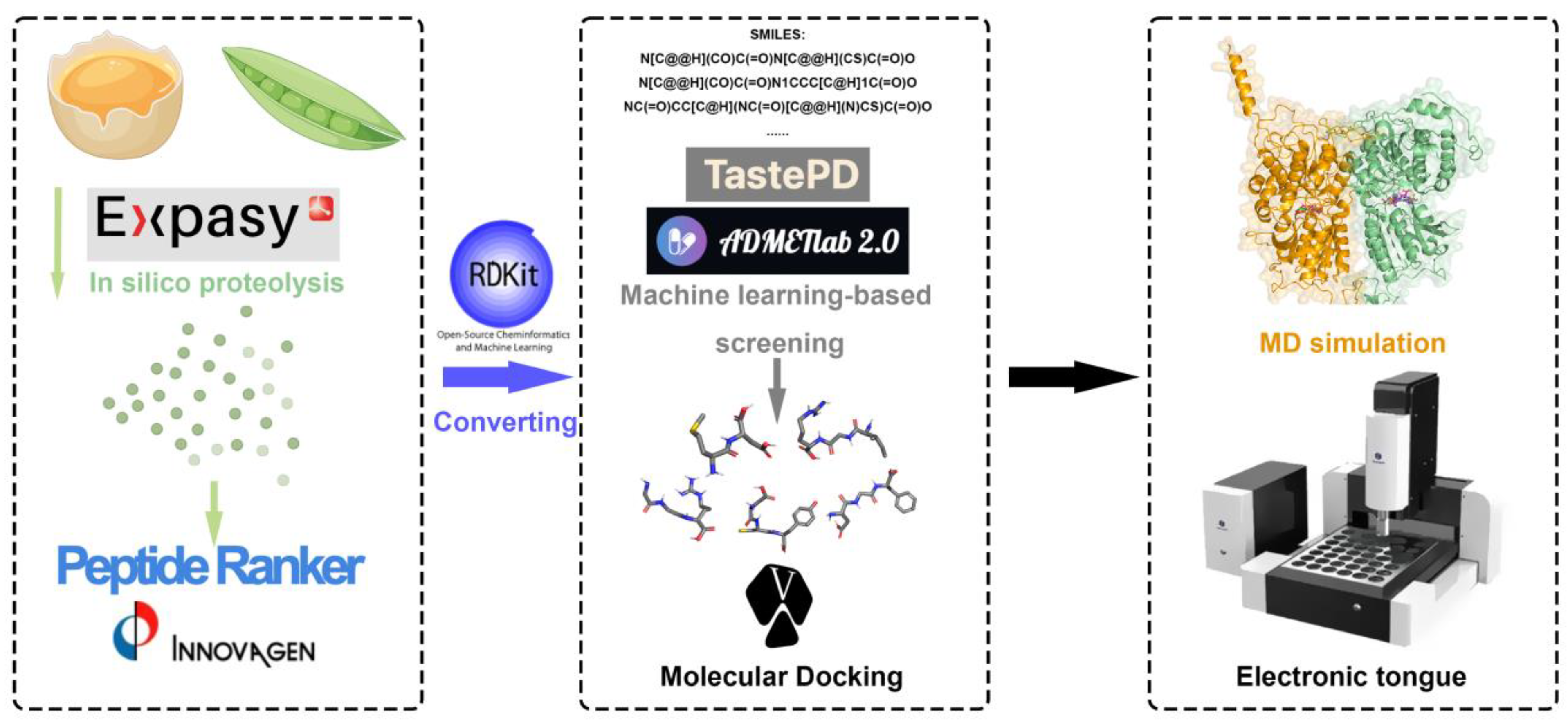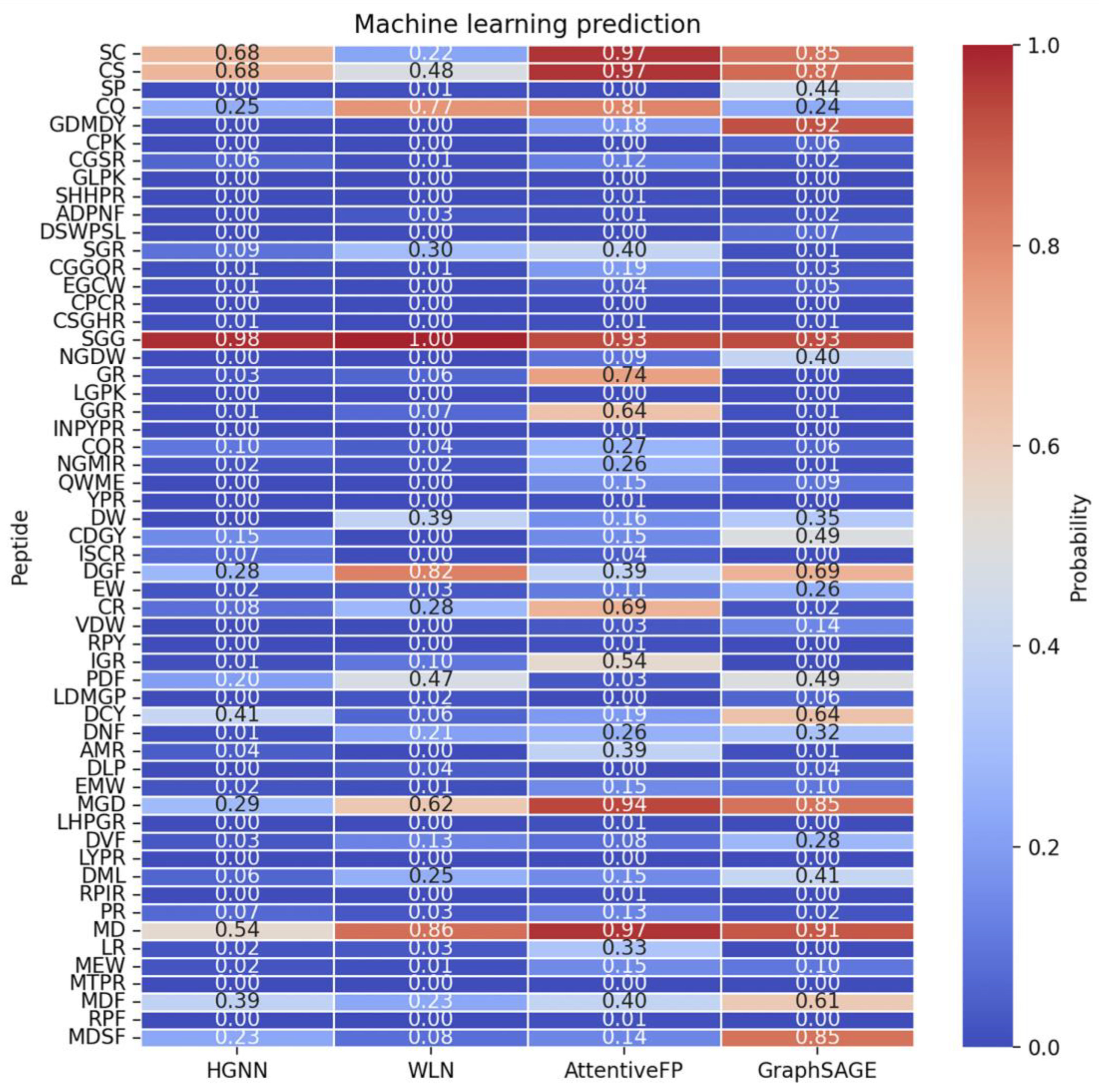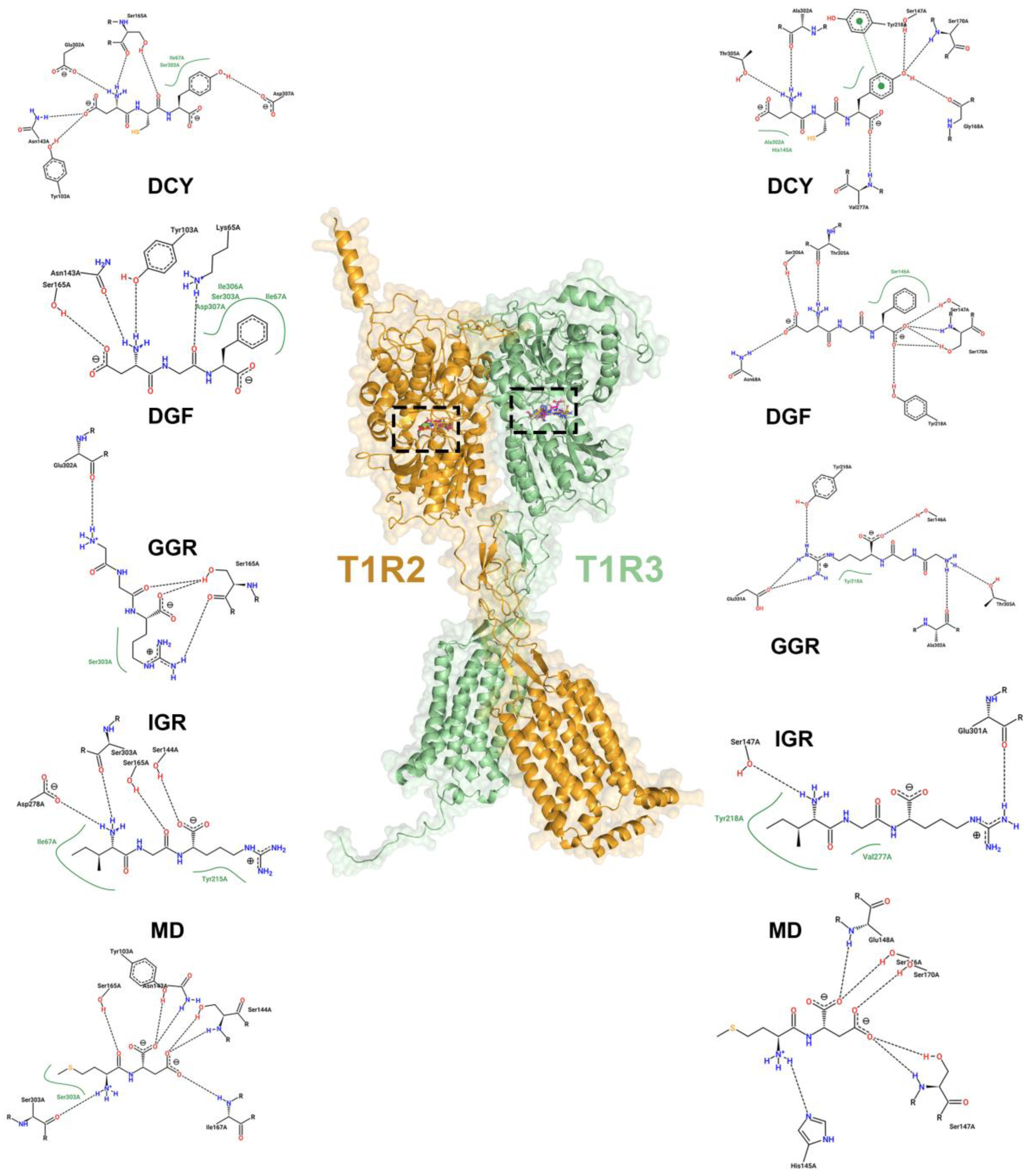Integrating Computational and Experimental Methods to Identify Novel Sweet Peptides from Egg and Soy Proteins
Abstract
:1. Introduction
2. Results and Discussion
2.1. Identification of Sweet Peptides
2.2. Peptides Screening Based on Structure
2.3. Electronic Tongue Analysis
3. Materials and Methods
3.1. Materials
3.2. Identification of Sweet Peptides
3.2.1. Virtual Enzymolysis of Protein
3.2.2. Prediction of Biological Activity, Water Solubility
3.2.3. Prediction of Sweetness and Toxicity of Peptides
3.3. Molecular Docking Screening
3.4. Molecular Dynamics Simulation
3.5. Taste Assessment of Peptides Using the Electronic Tongue
4. Conclusions
Supplementary Materials
Author Contributions
Funding
Institutional Review Board Statement
Informed Consent Statement
Data Availability Statement
Conflicts of Interest
References
- Salar, F.J.; Agulló, V.; García-Viguera, C.; Domínguez-Perles, R. Stevia vs. Sucrose: Influence on the Phytochemical Content of a Citrus-Maqui Beverage-A Shelf Life Study. Foods 2020, 9, 219. [Google Scholar] [CrossRef]
- Debras, C.; Chazelas, E.; Srour, B.; Kesse-Guyot, E.; Julia, C.; Zelek, L.; Agaësse, C.; Druesne-Pecollo, N.; Galan, P.; Hercberg, S.; et al. Total and added sugar intakes, sugar types, and cancer risk: Results from the prospective NutriNet-Santé cohort. Am. J. Clin. Nutr. 2020, 112, 1267–1279. [Google Scholar] [CrossRef]
- Gao, M.; Jebb, S.A.; Aveyard, P.; Ambrosini, G.L.; Perez-Cornago, A.; Carter, J.; Sun, X.; Piernas, C. Associations between dietary patterns and the incidence of total and fatal cardiovascular disease and all-cause mortality in 116,806 individuals from the UK Biobank: A prospective cohort study. BMC Med. 2021, 19, 83. [Google Scholar] [CrossRef]
- Moores, C.J.; Kelly, S.A.M.; Moynihan, P.J. Systematic Review of the Effect on Caries of Sugars Intake: Ten-Year Update. J. Dent. Res. 2022, 101, 1034–1045. [Google Scholar] [CrossRef]
- Stanner, S.; Spiro, A. Public health rationale for reducing sugar: Strategies and challenges. Nutr. Bull. 2020, 45, 253–270. [Google Scholar] [CrossRef]
- Tan, V.W.K.; Wee, M.S.M.; Tomic, O.; Forde, C.G. Temporal sweetness and side tastes profiles of 16 sweeteners using temporal check-all-that-apply (TCATA). Food Res. Int. 2019, 121, 39–47. [Google Scholar] [CrossRef]
- Wagoner, T.; McCain, H.; Foegeding, E.; Drake, M. Food texture and sweetener type modify sweetness perception in whey protein-based model foods. J. Sens. Stud. 2018, 33, e12333. [Google Scholar] [CrossRef]
- Pavanello, S.; Moretto, A.; La Vecchia, C.; Alicandro, G. Non-sugar sweeteners and cancer: Toxicological and epidemiological evidence. Regul. Toxicol. Pharmacol. 2023, 139, 105369. [Google Scholar] [CrossRef]
- Rios-Leyvraz, M.; Montez, J.; World Health Organization. Health Effects of the Use of Non-Sugar Sweeteners: A Systematic Review and Meta-Analysis; World Health Organization: Geneva, Switzerland, 2022. [Google Scholar]
- Chen, L.; Wu, W.; Zhang, N.; Bak, K.H.; Zhang, Y.; Fu, Y. Sugar reduction in beverages: Current trends and new perspectives from sensory and health viewpoints. Food Res. Int. 2022, 162 Pt B, 112076. [Google Scholar] [CrossRef]
- Turner, A.; Veysey, M.; Keely, S.; Scarlett, C.J.; Lucock, M.; Beckett, E.L. Intense Sweeteners, Taste Receptors and the Gut Microbiome: A Metabolic Health Perspective. Int. J. Environ. Res. Public Health 2020, 17, 4094. [Google Scholar] [CrossRef]
- Riboli, E.; Beland, F.A.; Lachenmeier, D.W.; Marques, M.M.; Phillips, D.H.; Schernhammer, E.; Afghan, A.; Assunção, R.; Caderni, G.; Corton, J.C.; et al. Carcinogenicity of aspartame, methyleugenol, and isoeugenol. Lancet Oncol. 2023, 24, 848–850. [Google Scholar] [CrossRef]
- Debras, C.; Chazelas, E.; Srour, B.; Druesne-Pecollo, N.; Esseddik, Y.; Szabo de Edelenyi, F.; Agaësse, C.; De Sa, A.; Lutchia, R.; Gigandet, S.; et al. Artificial sweeteners and cancer risk: Results from the NutriNet-Santé population-based cohort study. PLoS Med. 2022, 19, e1003950. [Google Scholar] [CrossRef]
- McCullough, M.L.; Hodge, R.A.; Campbell, P.T.; Guinter, M.A.; Patel, A.V. Sugar- and Artificially-Sweetened Beverages and Cancer Mortality in a Large U.S. Prospective Cohort. Cancer Epidemiol. Biomark. Prev. 2022, 31, 1907–1918. [Google Scholar] [CrossRef] [PubMed]
- Zhang, M.X.; Wang, X.C.; Liu, Y.; Xu, X.L.; Zhou, G.H. Isolation and identification of flavour peptides from Puffer fish (Takifugu obscurus) muscle using an electronic tongue and MALDI-TOF/TOF MS/MS. Food Chem. 2012, 135, 1463–1470. [Google Scholar] [CrossRef]
- Bian, Y.R.; Li, W.J.; Pan, L.H.; Peng, Q.M.; You, S.; Sheng, S.; Wang, J.; Wu, F.A. Sweet-flavored peptides with biological activities from mulberry seed protein treated by multifrequency countercurrent ultrasonic technology. Food Chem. 2022, 367, 130647. [Google Scholar] [CrossRef] [PubMed]
- Zhuang, M.; Lin, L.; Zhao, M.; Dong, Y.; Sun-Waterhouse, D.; Chen, H.; Qiu, C.; Su, G. Sequence, taste and umami-enhancing effect of the peptides separated from soy sauce. Food Chem. 2016, 206, 174–181. [Google Scholar] [CrossRef]
- Zhao, W.; Zhang, S.; Wang, Y.; Ding, L.; Yu, Z. Identification of bitter receptor T2R14 blocking peptides from egg protein via virtual screening and molecular docking. Food Sci. Anim. Prod. 2023, 1, 9240021. [Google Scholar] [CrossRef]
- Song, S.; Zhuang, J.; Ma, C.; Feng, T.; Yao, L.; Ho, C.T.; Sun, M. Identification of novel umami peptides from Boletus edulis and its mechanism via sensory analysis and molecular simulation approaches. Food Chem. 2023, 398, 133835. [Google Scholar] [CrossRef]
- Yu, Z.; Kang, L.; Zhao, W.; Wu, S.; Ding, L.; Zheng, F.; Liu, J.; Li, J. Identification of novel umami peptides from myosin via homology modeling and molecular docking. Food Chem. 2021, 344, 128728. [Google Scholar] [CrossRef]
- Huang, W.; Shen, Q.; Su, X.; Ji, M.; Liu, X.; Chen, Y.; Lu, S.; Zhuang, H.; Zhang, J. BitterX: A tool for understanding bitter taste in humans. Sci. Rep. 2016, 6, 23450. [Google Scholar] [CrossRef]
- Fritz, F.; Preissner, R.; Banerjee, P. VirtualTaste: A web server for the prediction of organoleptic properties of chemical compounds. Nucleic Acids Res. 2021, 49, W679–W684. [Google Scholar] [CrossRef] [PubMed]
- Garg, N.; Sethupathy, A.; Tuwani, R.; NK, R.; Dokania, S.; Iyer, A.; Gupta, A.; Agrawal, S.; Singh, N.; Shukla, S.; et al. FlavorDB: A database of flavor molecules. Nucleic Acids Res. 2017, 46, D1210–D1216. [Google Scholar] [CrossRef]
- Wang, K.; Cui, H.; Liu, K.; He, Q.; Fu, X.; Li, W.; Han, W. Exploring the anti-gout potential of sunflower receptacles alkaloids: A computational and pharmacological analysis. Comput. Biol. Med. 2024, 172, 108252. [Google Scholar] [CrossRef]
- He, Y.; Liu, K.; Cao, F.; Song, R.; Liu, J.; Zhang, Y.; Li, W.; Han, W. Using deep learning and molecular dynamics simulations to unravel the regulation mechanism of peptides as noncompetitive inhibitor of xanthine oxidase. Sci. Rep. 2024, 14, 174. [Google Scholar] [CrossRef]
- Liu, K.; Guo, F.; Ma, Y.; Yu, X.; Fu, X.; Li, W.; Han, W. Functionalized Fullerene Potentially Inhibits SARS-CoV-2 Infection by Modulating Spike Protein Conformational Changes. Int. J. Mol. Sci. 2023, 24, 14471. [Google Scholar] [CrossRef]
- Wang, M.; Liu, K.; Ma, Y.; Han, W. Probing the Mechanisms of Inhibitors Binding to Presenilin Homologue Using Molecular Dynamics Simulations. Molecules 2023, 28, 2076. [Google Scholar] [CrossRef]
- Nourmohammadi, E.; Mahoonak, A.S. Health Implications of Bioactive Peptides: A Review. Int. J. Vitam. Nutr. Res. 2018, 88, 319–343. [Google Scholar] [CrossRef]
- Zhu, Y.; Chen, G.; Diao, J.; Wang, C. Recent advances in exploring and exploiting soybean functional peptides-a review. Front. Nutr. 2023, 10, 1185047. [Google Scholar] [CrossRef]
- Schmutz, J.; Cannon, S.B.; Schlueter, J.; Ma, J.; Mitros, T.; Nelson, W.; Hyten, D.L.; Song, Q.; Thelen, J.J.; Cheng, J.; et al. Genome sequence of the palaeopolyploid soybean. Nature 2010, 463, 178–183. [Google Scholar] [CrossRef]
- Gasteiger, E.; Gattiker, A.; Hoogland, C.; Ivanyi, I.; Appel, R.D.; Bairoch, A. ExPASy: The proteomics server for in-depth protein knowledge and analysis. Nucleic Acids Res. 2003, 31, 3784–3788. [Google Scholar] [CrossRef] [PubMed]
- Mooney, C.; Haslam, N.J.; Pollastri, G.; Shields, D.C. Towards the improved discovery and design of functional peptides: Common features of diverse classes permit generalized prediction of bioactivity. PLoS ONE 2012, 7, e45012. [Google Scholar] [CrossRef]
- Lafarga, T.; O’Connor, P.; Hayes, M. In silico methods to identify meat-derived prolyl endopeptidase inhibitors. Food Chem. 2015, 175, 337–343. [Google Scholar] [CrossRef]
- Xiong, G.; Wu, Z.; Yi, J.; Fu, L.; Yang, Z.; Hsieh, C.; Yin, M.; Zeng, X.; Wu, C.; Lu, A.; et al. ADMETlab 2.0: An integrated online platform for accurate and comprehensive predictions of ADMET properties. Nucleic Acids Res. 2021, 49, W5–W14. [Google Scholar] [CrossRef]
- Jiang, D.; Lei, T.; Wang, Z.; Shen, C.; Cao, D.; Hou, T. ADMET evaluation in drug discovery. 20. Prediction of breast cancer resistance protein inhibition through machine learning. J. Cheminformatics 2020, 12, 16. [Google Scholar] [CrossRef]
- Dong, J.; Wang, N.-N.; Yao, Z.-J.; Zhang, L.; Cheng, Y.; Ouyang, D.; Lu, A.-P.; Cao, D.-S. ADMETlab: A platform for systematic ADMET evaluation based on a comprehensively collected ADMET database. J. Cheminformatics 2018, 10, 29. [Google Scholar] [CrossRef]
- Mirdita, M.; Schütze, K.; Moriwaki, Y.; Heo, L.; Ovchinnikov, S.; Steinegger, M. ColabFold: Making protein folding accessible to all. Nat. Methods 2022, 19, 679–682. [Google Scholar] [CrossRef]
- Jumper, J.; Evans, R.; Pritzel, A.; Green, T.; Figurnov, M.; Ronneberger, O.; Tunyasuvunakool, K.; Bates, R.; Žídek, A.; Potapenko, A.; et al. Highly accurate protein structure prediction with AlphaFold. Nature 2021, 596, 583–589. [Google Scholar] [CrossRef]
- Eberhardt, J.; Santos-Martins, D.; Tillack, A.F.; Forli, S. AutoDock Vina 1.2.0: New Docking Methods, Expanded Force Field, and Python Bindings. J. Chem. Inf. Model. 2021, 61, 3891–3898. [Google Scholar] [CrossRef]
- Forli, S.; Huey, R.; Pique, M.E.; Sanner, M.F.; Goodsell, D.S.; Olson, A.J. Computational protein-ligand docking and virtual drug screening with the AutoDock suite. Nat. Protoc. 2016, 11, 905–919. [Google Scholar] [CrossRef]
- Case, D.A.; Darden, T.A.; Cheatham, T.E.; Simmerling, C.L.; Roberts, B.P. AMBER 11. University of California: San Francisco, CA, USA, 2010. [Google Scholar]
- Maier, J.A.; Martinez, C.; Kasavajhala, K.; Wickstrom, L.; Hauser, K.E.; Simmerling, C. ff14SB: Improving the Accuracy of Protein Side Chain and Backbone Parameters from ff99SB. J. Chem. Theory Comput. 2015, 11, 3696–3713. [Google Scholar] [CrossRef]
- Jorgensen, W.L.; Chandrasekhar, J.; Madura, J.D.; Impey, R.W.; Klein, M.L. Comparison of simple potential functions for simulating liquid water. J. Chem. Phys. 1983, 79, 926–935. [Google Scholar] [CrossRef]
- Hopkins, C.W.; Le Grand, S.; Walker, R.C.; Roitberg, A.E. Long-Time-Step Molecular Dynamics through Hydrogen Mass Repartitioning. J. Chem. Theory Comput. 2015, 11, 1864–1874. [Google Scholar] [CrossRef] [PubMed]
- Darden, T.; York, D.; Pedersen, L. Particle mesh Ewald: An N⋅ log (N) method for Ewald sums in large systems. J. Chem. Phys. 1993, 98, 10089–10092. [Google Scholar] [CrossRef]
- Davidchack, R.L.; Handel, R.; Tretyakov, M.V. Langevin thermostat for rigid body dynamics. J. Chem. Phys. 2009, 130, 234101. [Google Scholar] [CrossRef]






| Peptide Sequence | SVM Score | Prediction | Hydrophobicity | Steric hindrance | Sidebulk | Hydropathicity | Amphipathicity | Hydrophilicity | Net Hydrogen | Charge | pI | Mol wt |
|---|---|---|---|---|---|---|---|---|---|---|---|---|
| SC | −0.8 | Non-Toxin | −0.11 | 0.57 | 0.57 | 0.85 | 0 | −0.35 | 0.5 | 0 | 5.85 | 208.24 |
| CS | −0.8 | Non-Toxin | −0.11 | 0.57 | 0.57 | 0.85 | 0 | −0.35 | 0.5 | 0 | 5.85 | 208.24 |
| SGG | −0.79 | Non-Toxin | 0.02 | 0.63 | 0.63 | −0.53 | 0 | 0.1 | 0.33 | 0 | 5.88 | 219.23 |
| MD | −0.8 | Non-Toxin | −0.23 | 0.77 | 0.77 | −0.8 | 0 | 0.85 | 0.5 | −1 | 3.8 | 264.31 |
| CQ | −0.8 | Non-Toxin | −0.32 | 0.65 | 0.65 | −0.5 | 0.62 | −0.4 | 1 | 0 | 5.85 | 249.3 |
| DGF | −0.82 | Non-Toxin | 0.02 | 0.71 | 0.71 | −0.37 | 0 | 0.17 | 0.33 | −1 | 3.8 | 337.36 |
| MGD | −0.81 | Non-Toxin | −0.1 | 0.74 | 0.74 | −0.67 | 0 | 0.57 | 0.33 | −1 | 3.8 | 321.38 |
| GR | −0.79 | Non-Toxin | −0.8 | 0.68 | 0.68 | −2.45 | 1.23 | 1.5 | 2 | 1 | 10.11 | 231.27 |
| GGR | −0.78 | Non-Toxin | −0.48 | 0.68 | 0.68 | −1.77 | 0.82 | 1 | 1.33 | 1 | 10.11 | 288.34 |
| CR | −0.8 | Non-Toxin | −0.86 | 0.65 | 0.65 | −1 | 1.23 | 1 | 2 | 1 | 8.6 | 277.35 |
| IGR | −0.82 | Non-Toxin | −0.29 | 0.69 | 0.69 | −0.13 | 0.82 | 0.4 | 1.33 | 1 | 10.11 | 344.45 |
| GDMDY | −0.83 | Non-Toxin | −0.2 | 0.74 | 0.74 | −1.36 | 0 | 0.48 | 0.6 | −2 | 3.57 | 599.67 |
| DCY | −0.74 | Non-Toxin | −0.22 | 0.69 | 0.69 | −0.77 | 0 | −0.1 | 0.67 | −1 | 3.8 | 399.44 |
| MDF | −0.84 | Non-Toxin | 0.05 | 0.75 | 0.75 | 0.4 | 0 | −0.27 | 0.33 | −1 | 3.8 | 411.5 |
| MDSF | −0.92 | Non-Toxin | −0.03 | 0.69 | 0.69 | 0.1 | 0 | −0.12 | 0.5 | −1 | 3.8 | 498.59 |
| Peptide | T1R2 | T1R3 | Sum |
|---|---|---|---|
| DGF | −7.4 | −8.2 | −15.6 |
| IGR | −7.2 | −7.8 | −15 |
| GGR | −7.6 | −7.1 | −14.7 |
| DCY | −6.9 | −7.8 | −14.7 |
| Aspartame | −7 | −7.2 | −14.2 |
| MD | −6 | −7.8 | −13.8 |
| MGD | −6.8 | −6.6 | −13.4 |
| GR | −6.8 | −6.4 | −13.2 |
| CR | −6.7 | −6.5 | −13.2 |
| MDF | −6.9 | −6.2 | −13.1 |
| CQ | −6.6 | −6.4 | −13 |
| MDSF | −4.7 | −7.9 | −12.6 |
| SGG | −6.3 | −5.7 | −12 |
| SC | −5.6 | −6.3 | −11.9 |
| GDMDY | −3.8 | −8 | −11.8 |
| CS | −5.8 | −5.6 | −11.4 |
| Peptide | T1R2 | T1R3 |
|---|---|---|
| DCY | −17.73 ± 2.22 | −1.91 ± 3.04 |
| GGR | −16.12 ± 2.17 | −34.23 ± 3.90 |
| IGR | −43.07 ± 3.09 | −20.86 ± 4.13 |
| DGF | −4.46 ± 2.36 | −12.57 ± 2.19 |
| MD | 18.82 ± 4.09 | −5.16 ± 4.60 |
| Sample Name | Parallel Experiment Number | Sourness | Bitterness | Astringency | Acidic Bitterness Aftertaste | Astringency Aftertaste | Umami | Richness | Saltiness | Sweetness |
|---|---|---|---|---|---|---|---|---|---|---|
| Tasteless point | −13 | 0 | 0 | 0 | 0 | 0 | 0 | −6 | 0 | |
| DCY | 1 | −2.33 | 6.68 | 7.82 | 1.06 | −0.32 | 0.32 | 1.94 | −12.96 | 16.48 |
| 2 | −2.49 | 4.71 | 6.02 | −0.83 | −1.47 | 0.61 | 1.79 | −13.32 | 17.10 | |
| 3 | −2.48 | 0.28 | 3.74 | 2.31 | 2.10 | 0.60 | 2.14 | −13.20 | 17.68 | |
| Mean value | −2.43 | 3.89 | 5.86 | 0.85 | 0.10 | 0.51 | 1.96 | −13.16 | 17.09 | |
| GGR | 1 | −13.37 | 10.65 | 8.38 | 0.61 | −0.20 | 3.57 | 1.85 | −6.47 | 23.15 |
| 2 | −13.48 | 11.58 | 10.26 | −0.74 | −1.19 | 3.77 | 1.79 | −6.94 | 22.80 | |
| 3 | −12.73 | 3.04 | 1.53 | −1.13 | −1.46 | 3.56 | 2.30 | −7.05 | 22.41 | |
| Mean value | −13.19 | 8.42 | 6.72 | −0.42 | −0.95 | 3.63 | 1.98 | −6.82 | 22.79 | |
| IGR | 1 | −4.99 | 5.73 | 6.29 | 1.35 | −0.35 | 1.56 | 1.47 | −7.22 | 18.73 |
| 2 | −5.28 | 2.19 | 2.16 | 0.88 | 0.46 | 1.71 | 1.46 | −7.47 | 19.27 | |
| 3 | −5.03 | −2.79 | −0.98 | −0.24 | −0.77 | 1.56 | 1.94 | −7.16 | 19.86 | |
| Mean value | −5.10 | 1.71 | 2.49 | 0.66 | −0.22 | 1.61 | 1.62 | −7.28 | 19.29 |
| Sensor | Taste | Aftertaste |
|---|---|---|
| C00 | Bitterness | Acidic Bitterness Aftertaste |
| AE1 | Astringency | Astringency Aftertaste |
| CA0 | Sourness | × |
| CT0 | Saltness | × |
| AAE | Umami | Richness |
| GL1 | Sweetness | × |
Disclaimer/Publisher’s Note: The statements, opinions and data contained in all publications are solely those of the individual author(s) and contributor(s) and not of MDPI and/or the editor(s). MDPI and/or the editor(s) disclaim responsibility for any injury to people or property resulting from any ideas, methods, instructions or products referred to in the content. |
© 2024 by the authors. Licensee MDPI, Basel, Switzerland. This article is an open access article distributed under the terms and conditions of the Creative Commons Attribution (CC BY) license (https://creativecommons.org/licenses/by/4.0/).
Share and Cite
Su, J.; Liu, K.; Cui, H.; Shen, T.; Fu, X.; Han, W. Integrating Computational and Experimental Methods to Identify Novel Sweet Peptides from Egg and Soy Proteins. Int. J. Mol. Sci. 2024, 25, 5430. https://doi.org/10.3390/ijms25105430
Su J, Liu K, Cui H, Shen T, Fu X, Han W. Integrating Computational and Experimental Methods to Identify Novel Sweet Peptides from Egg and Soy Proteins. International Journal of Molecular Sciences. 2024; 25(10):5430. https://doi.org/10.3390/ijms25105430
Chicago/Turabian StyleSu, Jinhao, Kaifeng Liu, Huizi Cui, Tianze Shen, Xueqi Fu, and Weiwei Han. 2024. "Integrating Computational and Experimental Methods to Identify Novel Sweet Peptides from Egg and Soy Proteins" International Journal of Molecular Sciences 25, no. 10: 5430. https://doi.org/10.3390/ijms25105430
APA StyleSu, J., Liu, K., Cui, H., Shen, T., Fu, X., & Han, W. (2024). Integrating Computational and Experimental Methods to Identify Novel Sweet Peptides from Egg and Soy Proteins. International Journal of Molecular Sciences, 25(10), 5430. https://doi.org/10.3390/ijms25105430







